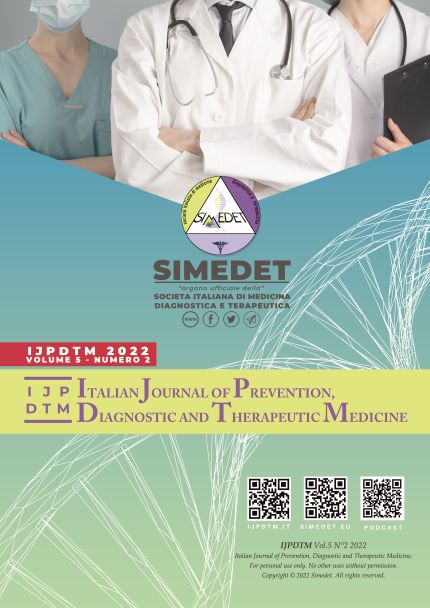Single venous access center and venous access referral network experience on the application of an organizational model in the university hospital
Main Article Content
Abstract
INTRODUCTION
In recent years, the use of PICCs (peripherally inserted central catheter) has increased compared to other types of venous access. Their versatility and low risk often make them a first choice in the medium to long term (3 months). Many healthcare companies, based on the premise made, have strategically invested in the establishment of dedicated clinics and the training of PICC Teams.
MATERIALS AND METHODS
This work aims to describe the establishment and implementation of the centralized service for the management of medium and long-term venous access within the AOU of Cagliari (CUAV); placing the emphasis on the establishment of a network of contacts for the management of venous access within the individual operating units. The process of establishing the centralized service for access management and the establishment of the network of contacts was undertaken in order to reduce the waiting times for the implantation of an indwelling venous catheter and accelerate the procedure for discharging patients. fragile on the territory. In order to demonstrate the organizational impact of the organizational model adopted, the following data relating to 2017 and 2021 were collected through the implant registers: the number and type of long-term central venous catheters implanted, the average waiting times and the main indications for the system.
In this paper, the organizational model adopted from 2018 to 2020 was described and the organizational implications in the management of venous accesses were analyzed.
RESULTS
The AOU company of Cagliari, in 2018, implemented the existing long-stay port-cath and partially tunneled catheter positioning service, integrating it with the PICC implant service.
Active since 2007, the long-term central venous catheter implantation service is mainly aimed at cancer patients suffering from solid malignant neoplasms. Grosshong type catheters were implanted in 63.9% of cases, Port-a-cath catheters in the remaining 36.1% of cases. The average waiting times for the implant were quantified in about 8 weeks of waiting, an excessively long time considering the needs of cancer patients waiting for chemotherapy.
The activation of the single company center for the implantation of long-stay venous catheters and the network of contact persons in the management, led to a reduction in waiting times of 7 days, an increase in PICC and MIDLINE implants and an improvement in entire management process.
CONCUSIONS
Venous access requires the activation of clinical paths aimed at the timely assessment of the venous heritage, planning, and the insertion of the appropriate device, it is able to improve results by reducing variables, the fragmentation of care and consequently the cost .
The PICC -Team or Medical-Nursing Teams for medium and long-term venous access fit perfectly into this logic.
The mere presence of a PICC team does not guarantee the improvement of the quality of care. The successful positioning of peripheral accesses (short, long and midline cannulas) and central accesses depends on a specialized team and the application of bundles by all the operators involved in the management of this type of device, thus reducing complications.
This is possible if the PICC team is associated with the collaboration of the network of specifically trained referring nurses.
The organizational model of the network of venous access referents adopted in AOU is providing answers consistent with expectations and it is desirable that they will be confirmed by the monitoring and evaluation of the data also for next year.
Downloads
Article Details

This work is licensed under a Creative Commons Attribution-NonCommercial-NoDerivatives 4.0 International License.
References
Moureau NL, Trick N, Nifong T, Perry C, Kelley C, Carrico R, et al. Vessel health and preservation (part 1): A new evidence-based approach to vascular access selection and management. J Vasc Access. 2012;13(3):351–6.
Crouton M. RCN Infusion Therapy Standards review. R Coll Nurs. 2004.
O’Grady NP, Alexander M, Burns LA, Dellinger EP, Garland J, Heard SO, et al. Guidelines for the prevention of intravascular catheter-related infections. Clin Infect Dis . 2011 May 52(9):e162-93.
Lisa A. Gorski MS, Lynda Cook, James M. Joseph, Kathy Kokotis, Sabatino-Holmes LVG. NDevelopment of an Evidence-Based List of Noncytotoxic Vesicant Medications and Solutions [Internet]. INS INFUSIUON NURSES SOCIETY. 2016 .
Pittiruti M, Hamilton H, Biffi R, MacFie J, Pertkiewicz M; ESPEN. ESPEN Guidelines on Parenteral Nutrition: central venous catheters (access, care, diagnosis and therapy of complications). Clin Nutr. 2009 Aug;28(4):365-77.
Pittirutti M, Scoppettuolo G., Raccomandazioni gavecelt 2021 per la indicazione, l’impianto e la gestione dei dispositivi per accesso. Dal sito Gavecelt venosohttps://gavecelt.it/nuovo/sites/default/files/ uploads/Raccomandazioni%20GAVeCeLT%202021.pdf .
Nursing Best Practice Guideline Shaping the future of Nursing. RNAO Nurs Best Parctice Guidel Progr. 2005.
Standards for infusion therapy 4° edition 2016 Royal college of Nursing.
Guidelines for the Prevention of Intravascular Catheter- Related Infections, 2011 Accessible version: https://www.cdc.gov/ infectioncontrol/guidelines/bsi/index.html.
Tabella farmaci per infusione. Sito web del GAVeCeLT. https:// www.gavecelt.it/nuovo/sites/default/files/uploads/lista_farmaci_per_ infusione.pdf.
http://www.salute.gov.it/imgs/C_17_pubblicazioni_2651_ allegato.pdf(Rapporto attività di ricovero ospedaliero SDO 2016).
Webster J, Osborne S, Rickard CM, New K. Clinically-indicated replacement versus routine replacement of peripheral venous catheters. Cochrane Database Syst Rev . 2013;(4):CD007798. doi:10.1002/14651858.CD007798.pub3.
Perucca, R. Peripheral venous access devices. In: Alexander M, Corrigan A, Gorski L, Hankins J, Perucca R, eds. Infusion Nursing: An Evidence-Based Approach. 3rd ed. St Louis, MO:Saunders/Elsevier; 2010:456-479.

